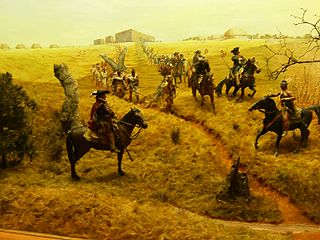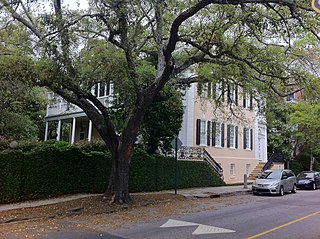Related Research Articles

Colleton County is in the Lowcountry region of the U.S. state of South Carolina. As of the 2010 census, the county's population was 38,892. Its county seat is Walterboro. The county is named after Sir John Colleton, 1st Baronet, one of the eight Lords Proprietor of the Province of Carolina. After two previous incarnations, the current Colleton County was created in 1800.

Walterboro is a city in Colleton County, South Carolina, United States. The city's population was 5,398 at the 2010 census. It is the county seat of Colleton County. Walterboro is located 48 miles (77 km) west of Charleston and is located near the ACE Basin region in the South Carolina Lowcountry. It is known as "The Front Porch of the Lowcountry".

Province of South Carolina, originally known as Clarendon Province, was a province of Great Britain that existed in North America from 1712 to 1776. It was one of the five Southern colonies and one of the thirteen American colonies. The monarch of Great Britain was represented by the Governor of South Carolina, until the colonies declared independence on July 4, 1776.

Province of North Carolina was a province of Great Britain that existed in North America from 1712(p. 80) to 1776. It was one of the five Southern colonies and one of the thirteen American colonies. The monarch of Great Britain was represented by the Governor of North Carolina, until the colonies declared independence on July 4, 1776.

Province of Carolina was a province of England (1663–1707) and Great Britain (1707–1712) that existed in North America and the Caribbean from 1663 until partitioned into North and South on January 24, 1712. It is part of present-day Alabama, Georgia, Mississippi, North Carolina, South Carolina, Tennessee, and The Bahamas.

Sir John Yeamans, 1st Baronet was an English colonial administrator and planter who served as Governor of Carolina from 1672 to 1674. Contemporary descriptions of Yeamans described him as "a pirate ashore."

Stede Bonnet was an early 18th-century Barbadian pirate, sometimes called "The Gentleman Pirate" because he was a moderately wealthy land-owner before turning to a life of crime. Bonnet was born into a wealthy English family on the island of Barbados, and inherited the family estate after his father's death in 1694. On November 21, 1709, twenty-one-year-old Stede Bonnet married sixteen-year-old Mary Allamby.

James Moore was an Irish colonial administrator and military officer who served as the governor of Carolina from 1700 to 1703. He is best known for leading several invasions of Spanish Florida during Queen Anne's War, including attacks in 1704 and 1706 which wiped out most of the Spanish missions in Florida. He captured and brought back to Carolina as slaves thousands of Apalachee Indians.
A lord proprietor is a person granted a royal charter for the establishment and government of an English colony in the 17th century. The plural of the term is "lords proprietors" or "lords proprietary".

Colonel William Rhett was a British-born plantation owner in the Province of Carolina in the late 17th and early 18th centuries. He arrived in America in 1694, accompanied by his wife Sarah. Rhett quickly became a prominent rice farmer and member of the South Carolina Assembly.

Sir John Colleton, 1st Baronet (1608–1666) served King Charles I during the English Civil War. He rose through the Royalist ranks during the conflict, but later had his land-holdings seized when the Cavaliers were finally defeated by Parliamentary forces. Following the Restoration of the Monarchy in 1660, he was one of eight individuals rewarded with grants of land in Carolina by King Charles II for having supported his efforts to regain the throne.
Henry Woodward, was a Barbados-born merchant and colonist who was one of the first white settlers in the Carolinas. He established relationships with many Native American Indians in the American southeast. He initiated trade, primarily in deerskins and slaves, with many Indian towns and tribes.

The history of Charleston, South Carolina, is one of the longest and most diverse of any community in the United States, spanning hundreds of years of physical settlement beginning in 1670. Charleston was one of leading cities in the South from the colonial era to the Civil War in the 1860s. The city grew wealthy through the export of rice and, later, sea island cotton and it was the base for many wealthy merchants and landowners.
James Colleton was a governor of the English proprietary Province of Carolina from 1686 to 1690.
Joseph Morton was an early colonist and governor of the Province of Carolina. Although he was not one of Carolina's Lords Proprietors, Morton was influential in the recruitment of religious dissenters to migrate to the new colony. In 1680 he led a group of dissenters to what is now South Carolina, settling Edisto Island. In 1682 he was appointed governor of the colony by the proprietors, but due to disagreements with the proprietors was replaced in 1684. A second appointment in 1686 lasted only one month before he was supplanted by James Colleton. Morton had been in the process of organizing an expedition against Spanish Florida, which the colonists believed was harboring pirates operating against the colony's coastal settlements. Colleton immediately put a stop to the expedition, since England and Spain were then at peace.
Robert Gibbes was an English Landgrave, chairman and acting governor of the province of South Carolina between 1710-1712. Although he was elected acting governor by the Executive Council between the three proprietary deputies of former governor, Edward Tynte, after his death, received one vote more than his opponent Thomas Broughton, getting it through bribery. This sparked a conflict between both the oppositions and their supporters which finished with the Lords Proprietors declaring the election of Gibbes illegal and the appointment of Charles Craven as governor of South Carolina in 1711, who didn't arrive until 1712.

The Grand Model was a utopian plan for the Province of Carolina, founded in 1670. It consisted of a constitution coupled with a settlement and development plan for the colony. The former was titled the Fundamental Constitutions of Carolina. The word "constitutions" was synonymous with "articles." The document was composed of 120 constitutions, or articles. The settlement and development plan for the colony consisted of several documents, or "instructions," for guiding town and regional planning as well as economic development.
Richard Tookerman was born on 16 May 1691 in Devon, Cornwall, England. He was the son of Josias Tookerman, a clergyman, and younger brother of Josias Tookerman II, a clergyman sent by the Society for the Propagation of the Gospel (SPG) to Jamaica. He married Katherine Grant, widow of John Grant of Charleston, South Carolina by 1717. As a pirate, smuggler, and trader active in the Caribbean and the Carolinas, he became best known for involvement with pirates Stede Bonnet and Bartholomew Roberts.
Nicolas Brigaut (1653–1686) was a French pirate and buccaneer active in the Caribbean. He was closely associated with fellow corsair Michel de Grammont.
Joseph Wragg was a politician and slave trader in the Province of South Carolina. Born Chesterfield, Derbyshire, Wragg immigrated to the American colonies where he became a pioneer in the slave trade. During the 1730s, Wragg was the predominant slave trader in South Carolina. The neighborhood of Wraggborough in Charleston, South Carolina is named for him; and two city parks and seven streets in Charleston are named for him and his descendants.
References
- ↑ Dow, George Francis; Edmonds, John Henry (2012). The Pirates of the New England Coast 1630-1730. New York: Courier Corporation. p. 31. ISBN 9780486138145 . Retrieved 20 August 2017.
- ↑ Little, Charles; Brown, James (1838). COLLECTIONS OF THE MASSACHUSETTS HISTORICAL SOCIETY. Boston: Freeman and Bolles. p. 157. Retrieved 20 August 2017.
- ↑ LiBrizzi, Marcus (2017). Haunted Islands in the Gulf of Maine. Lanham MD: Down East Books. ISBN 9781608939794 . Retrieved 20 August 2017.
- ↑ Little, Benerson (2007). The Buccaneer's Realm: Pirate Life on the Spanish Main, 1674-1688. Washington DC: Potomac Books, Inc. p. 70. ISBN 9781597971010 . Retrieved 20 August 2017.
- ↑ Fortescue, J.W. (1899). America and West Indies: March 1687, 1-15 | British History Online. London: Her Majesty's Stationery Office. pp. 324–343. Retrieved 20 August 2017.
